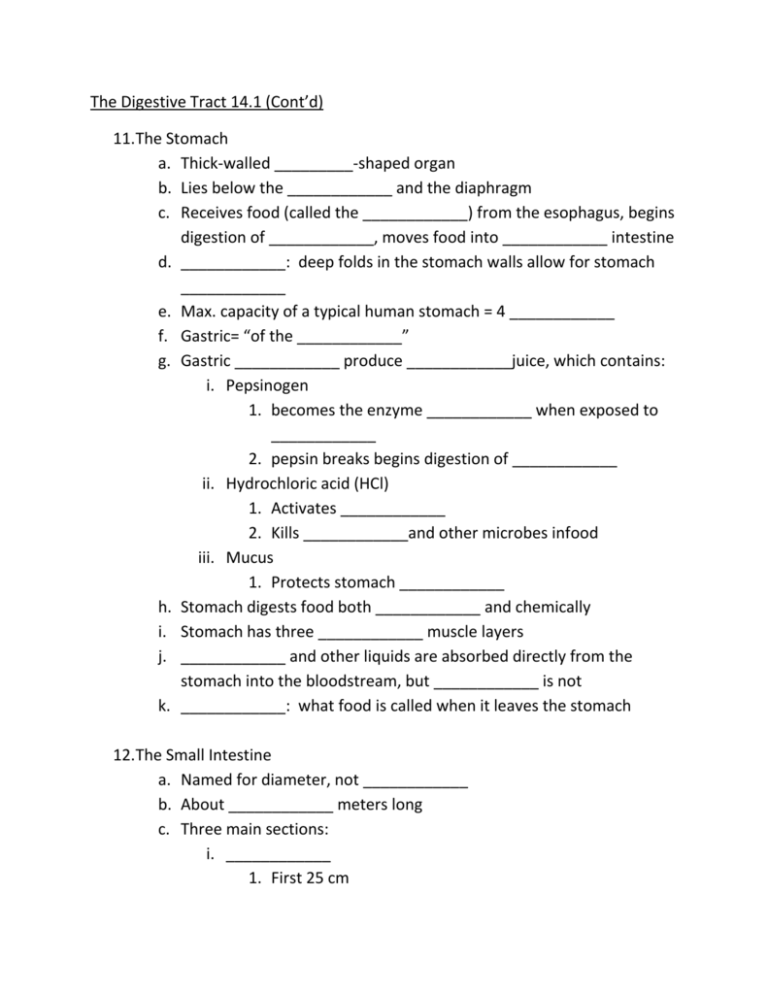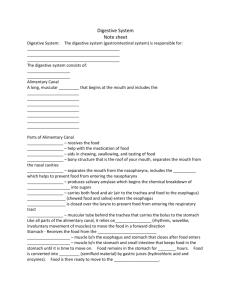The Digestive Tract 14.1 continued
advertisement

The Digestive Tract 14.1 (Cont’d) 11.The Stomach a. Thick-walled _________-shaped organ b. Lies below the ____________ and the diaphragm c. Receives food (called the ____________) from the esophagus, begins digestion of ____________, moves food into ____________ intestine d. ____________: deep folds in the stomach walls allow for stomach ____________ e. Max. capacity of a typical human stomach = 4 ____________ f. Gastric= “of the ____________” g. Gastric ____________ produce ____________juice, which contains: i. Pepsinogen 1. becomes the enzyme ____________ when exposed to ____________ 2. pepsin breaks begins digestion of ____________ ii. Hydrochloric acid (HCl) 1. Activates ____________ 2. Kills ____________and other microbes infood iii. Mucus 1. Protects stomach ____________ h. Stomach digests food both ____________ and chemically i. Stomach has three ____________ muscle layers j. ____________ and other liquids are absorbed directly from the stomach into the bloodstream, but ____________ is not k. ____________: what food is called when it leaves the stomach 12.The Small Intestine a. Named for diameter, not ____________ b. About ____________ meters long c. Three main sections: i. ____________ 1. First 25 cm 2. Ducts from ____________ and ____________ join here and form one common ____________ duct a. Receives ____________ from liver i. ____________ fat (makes it into tiny droplets) b. Receives pancreatic ____________ from pancreas i. ____________ stomach acid with sodium ____________ (NaHCO3) and makes small intestine slightly ____________ ii. Enzymes complete food ____________ ii. Jejunum 1. ____________ part 2. Most nutrient ____________ occurs here iii. ____________ 1. Last part 2. Attaches to ____________ intestine d. Surface Area i. Nutrient absorption occurs more efficiently with an increased ____________ area to ____________ ratio ii. Surface area of the small intestine = about the area of one ____________ court iii. Small intestine accomplishes this through ____________ and microvilli iv. Villus (singular villi) contain: 1. Microvilli a. Thousands of microvilli per villi b. Hair-like projections from villi c. Site of ____________ absorption 2. Capillaries a. Nutrients are absorbed into blood ____________ and ____________ capillaries b. A lymphatic capillary is called a ____________ c. The lymphatic system runs along the ____________ system and carries the fluid called ____________ to the cardiovascular ____________ d. ____________ and amino acids enter blood capillaries ____________ e. Secretion of Digestive Juices i. Promoted by the ____________ system and ____________ ii. Hormone is a substance ____________ by one set of ____________ that affects another set of cells (called ____________ cells) 1. ____________: hormone produced by stomach in presence of protein to promote gastric ____________ 2. Secretin: production stimulated by presence of ____________ 3. CCK (cholecystokinin): production stimulated by presence of partially digested ____________ and ____________ 4. Secretin and CCK: stimulate the ____________ to produce and release pancreatic juice, stimulates the liver to produce ____________ and stimulates gallbladder to ____________ bile 13.The Large Intestine a. Food that has not been digested (and some water) travels to the large intestine through a valve that prevents food from returning to the ____________ intestine b. absorbing ____________ is nearly finished c. main function is to remove water and form ____________ waste that can be ____________ d. The large intestine is made up of three parts: i. The ____________ (pronounced: see-kum) 1. a pouch at the beginning of the ____________intestine that joins the small ____________ to the large intestine. 2. The appendix, a small, hollow, finger-like pouch, hangs off the ____________. Doctors believe the appendix is left over from a previous time in human evolution. It no longer appears to be useful to the digestive process. 3. The colon extends from the ____________ up the right side of the abdomen, across the upper ____________, and then down the left side of the abdomen, finally connecting to the ____________. 4. The colon has three parts: the ____________ colon and ____________ colon, which absorb water and salts, and the ____________ colon, which holds the resulting waste. Bacteria in the colon help to digest the remaining food products. e. The rectum is where ____________ are stored until they leave the digestive system through the ____________ as a bowel movement. Make sure you’ve answered p.261 #1+2 and p.262 #1+2 Read pp.263-264 and answer p.264 #1+2 for next class. The Digestive Tract 14.1 (Cont’d) 14. The Stomach http://www.youtube.com/watch?v=08VyJOEcDos&feature=related a. Thick-walled J-shaped organ b. Lies below the liver and the diaphragm c. Receives food (the bolus) from the esophagus, begins digestion of proteins, moves food into small intestine d. Rugae: deep folds in the stomach walls allow for stomach expansion e. Max. capacity of a typical human stomach = 4 liters f. Gastric= “of the stomach” g. Gastric glands produce gastric juice, which contains: i. Pepsinogen 1. becomes the enzyme pepsin when exposed to HCl 2. pepsin breaks begins digestion of proteins ii. Hydrochloric acid (HCl) 1. Activates pepsinogen 2. Kills bacteria and other microbes in food iii. Mucus 1. Protects stomach lining h. Stomach digests food both mechanically and chemically i. http://www.youtube.com/watch?v=o18UycWRsaA&feature=related i. Stomach has three smooth muscle layers j. Alcohol and other liquids are absorbed directly from the stomach into the bloodstream, but food is not k. Chyme: what food is called when it leaves the stomach 15. The Small Intestine a. Named for diameter, not length b. About 6 meters long c. Three main sections: i. Duodenum 1. First 25 cm 2. Ducts from liver and pancreas join here and form one common bile duct a. Receives bile from liver i. Emulsifies fat (makes it into tiny droplets) b. Receives pancreatic juice from pancreas i. Neutralizes stomach acid with sodium bicarbonate (NaHCO3) and makes small intestine slightly basic ii. Enzymes complete food digestion ii. Jejunum 1. Middle part 2. Most nutrient absorption occurs here iii. Ileum 1. Last part 2. Attaches to large intestine d. Surface Area i. Nutrient absorption occurs more efficiently with an increased surface area to volume ratio ii. Surface area = about the area of one tennis court iii. Small intestine accomplishes this through villi and microvilli iv. Villus (singular villi) 1. Microvilli: a. Thousands of microvilli per villi b. Hair-like projections from villi c. Site of nutrient absorption 2. Capillaries a. Nutrients are absorbed into blood capillaries and lymphatic capillaries b. A lymphatic capillary is called a lacteal c. The lymphatic system runs along the cardiovascular system and carries the fluid called lymph to the cardiovascular veins d. Sugar and amino acids enter blood capillaries directly e. Secretion of Digestive Juices i. Promoted by the nervous system and hormones ii. Hormone is a substance produced by one set of cells that affects another set of cells (called the target cells) 1. Gastrin: hormone produced by stomach in presence of protein to promote gastric secretions 2. Secretin: production stimulated by presence of HCl 3. CCK (cholecystokinin): production stimulated by presence of partially digested fat and protein a. Secretin and CCK: stimulate the pancreas to produce and release pancreatic juice, stimulates the liver to produce bile and stimulates gallbladder to release bile 16. The Large Intestine a. food that has not been digested (and some water) travels to the large intestine through a valve that prevents food from returning to the small intestine. b. absorbing nutrients is nearly finished c. main function is to remove water and form solid waste that can be excreted d. The large intestine is made up of three parts: i. The cecum (pronounced: see-kum) 1. a pouch at the beginning of the large intestine that joins the small intestine to the large intestine. 2. The appendix, a small, hollow, finger-like pouch, hangs off the cecum. Doctors believe the appendix is left over from a previous time in human evolution. It no longer appears to be useful to the digestive process. ii. The colon extends from the cecum up the right side of the abdomen, across the upper abdomen, and then down the left side of the abdomen, finally connecting to the rectum. 1. The colon has three parts: the ascending colon and transverse colon, which absorb water and salts, and the descending colon, which holds the resulting waste. Bacteria in the colon help to digest the remaining food products. iii. The rectum is where feces are stored until they leave the digestive system through the anus as a bowel movement. Make sure you’ve answered p.261 #1+2 and p.262 #1+2 Read pp.263-264 and answer p.264 #1+2 for next class.









